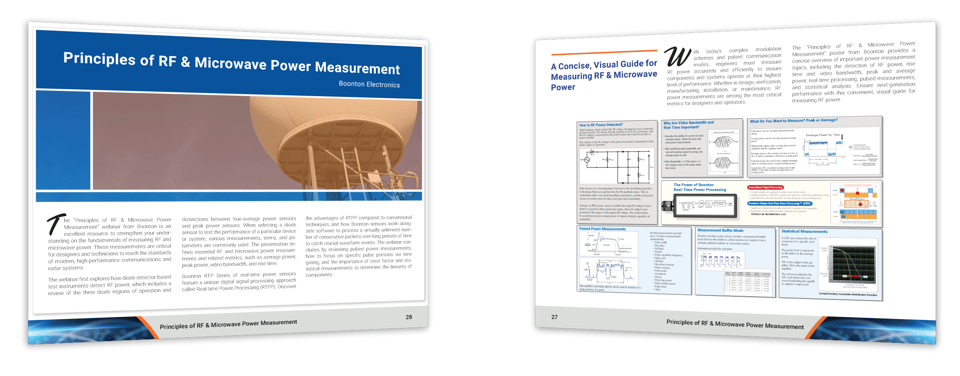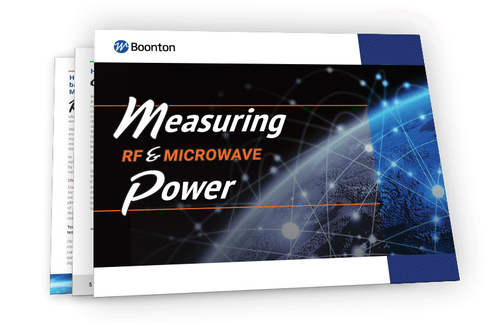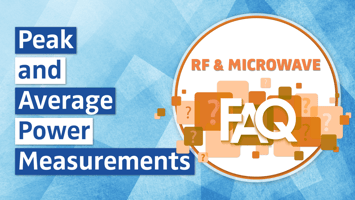Peak and average power measurements offer valuable insight on signal behavior and system...
Looking for an Excellent Resource on RF & Microwave Power Measurements? Read This eBook
From radar to Wi-Fi 6/6E to 5G, numerous applications rely on accurate RF and microwave power measurements, whether to ensure efficient operation, adhere to regulatory and safety standards, or protect system components.
The “Measuring RF & Microwave Power” eBook from Boonton serves as a comprehensive resource on power measurement essentials. Read the blog post below for a sneak peek of the eBook’s contents.
RF Power Detection
Thermal sensors, receiver-based amplitude measurements, RF sampling, and diode detector-based sensors are all different technologies used to capture RF power. How do diode detector-based test instruments measure RF power? What are the different diode regions of operation? The eBook first explores these essential questions, delving into the details of RF power detection.
Pulsed Power Measurements
Instead of continuous waveforms (CW), certain applications use pulsed-modulated RF signals that change between different states, either “on” or “off.” Radar antennas, for example, transmit pulsed RF signals and receive target reflections for analysis.
There are various ways to characterize a pulsed signal, whether it be the pulse period, pulse width, or pulse repetition frequency (PRF), among other parameters. Readers of the eBook will learn sixteen essential terms related to pulsed signals as well as how to take basic pulse readings with the Boonton RTP5000 Series and Boonton Power Analyzer (BPA) software.
Video Bandwidth, Rise Time, & Statistical Measurements
The video bandwidth (VBW) of a sensor indicates its ability to track a signal’s profile, meaning its amplitude variations. Rise time denotes the time period of a signal to change from 10% to 90% of the pulse magnitude.
Readers will learn why VBW and rise time are important parameters when choosing a power sensor, and how crest factor values and statistical analysis such as the complementary cumulative distribution function (CCDF) can be used to assess the linearity of amplifiers.
.00_00_01_03.Still001.png?width=2109&height=884&name=NEW%20-%20bebook%20(converted).00_00_01_03.Still001.png)
Peak Power & Average Power
Does your application require a peak power sensor or an average power sensor? For applications that utilize pulsed RF signals, the triggering capabilities of peak power sensors enables the synchronization of pulse measurements. Important features when selecting a peak power sensor solution include VBW, rise time, and crest factor/statistical analysis. Average power sensors are used to measure a waveform’s average power level over time instead of instantaneous envelope power measurements.
The “Peak Power & Average Power” section dives into the nuances between these two sensor types and the distinctions between specific peak and average power measurements.
Measurement Speed & Duration
100,000 measurements per second – that’s the rapid, gap-free measurement rate achieved by the Boonton RTP5000 Series and RTP4000 Series power sensors. This performance is linked to a parallel signal processing technique referred to as Real-time Power ProcessingTM (RTPP) technology. Combining this performance with the Boonton RTP Series Measurement Buffer Mode Application allows signal analysis over lengthy testing windows.
In this eBook section, learn how RTPP compares to conventional signal processing techniques and how the leading performance of RTPP-backed power sensors provides improved analysis and test results for various applications across different industries.
Principles of RF & Microwave Power Measurement
The eBook features two resources that cover the fundamentals of power measurements – a poster and webinar.
The poster is perfect for those looking for a concise, visual guide on the quick hits of measuring RF and microwave power. It covers RF power detection, VBW and rise time, peak and average power, pulsed power measurements, RTPP technology, the RTP Series Measurement Buffer Mode Application, and statistical analysis. The webinar provides further detail for each of the poster’s main topics with insightful descriptions and measurement examples.

RF Test Solutions by Application
The eBook highlights important test instrument considerations and crucial RF and microwave power measurements for three different applications – Wi-Fi 6/6E, radar, and 5G Time Division Duplex (TDD) networks.
Wi-Fi 6/6E Characterization: Testing 80 MHz and 160 MHz Wi-Fi 6/6E channels requires RF power sensors with adequate VBW capabilities to avoid measurement errors and inaccuracy. The Boonton RTP5000 Series offers the widest VBW available at 195 MHz to measure Wi-Fi 6/6E channels. In addition to VBW, important test instrument capabilities for Wi-Fi 6/6E include crest factor and CCDF, multi-channel measurements, time gating, and extended measurement windows.
Radar System Testing: Boonton USB RF power sensors and the PMX40 RF Power Meter offer a unique solution for testing secondary surveillance radar (SSR), no matter the stage of the system’s lifecycle. Whether its industry leading performance, portability, or multi-channel measurement capability, Boonton offers an all-in-one solution for radar system testing.
5G TDD Network Timing: Test instruments need to be able to capture the switching speed of 5G TDD networks to analyze performance accurately. A sensor with fast measurement speed (RTP5000 Series: 100,000 measurements per seconds), quick rise times (RTP5000 Series: 3 nanoseconds), and fine time resolution (RTP5000 Series: 100 picoseconds) enables validation of 5G TDD network performance.
Available Now: "Measuring RF & Microwave Power" eBook
You can read through the “Measuring RF & Microwave Power” eBook today by simply filling out the form below.




